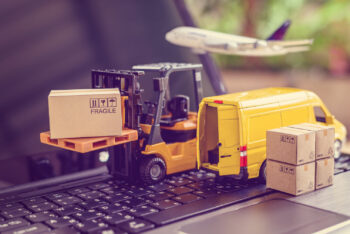Customer product returns resulting from online purchases are here to stay. Globally, eCommerce returns represent around 20% of all purchases, much higher than returns to stores. Statistics show that over 10,000 tons of returned goods end up in landfills each year.
Products that require a certain fit, like apparel and footwear have a higher return rate than a one-size-fits-all product such as a mobile phone. On the plus side, customers are becoming increasingly aware of the environmental implications and are putting pressure on retailers to become more sustainable.
There are three main ways returns impact the environment:
- Carbon emissions from vehicles
- Waste products contribute to landfills
- The use of excess and unsuitable packaging
On the Road

Every returned package leaves a trail of emissions whether carried by road, rail, sea or air. Pollution contributes to a reduction in air quality. Despite the movement towards electric and hybrid trucks, the problem is getting worse due to the growing numbers of returns. According to Optoro, the returns technology specialist, 15m tons of CO2 are emitted annually during the returns process.
Progress is made by 3PL carriers, couriers and consultants who are providing innovative solutions. Some are aggregating and consolidating returns for the retailer, saving money and saving the planet. Insightful retailers are offering options of greener shipping options that limit the carbon footprint whilst building customer loyalty.
Returns That Can Be Repurposed or Recycled
The decision on whether to repurpose an item comes down to the cost.
 It can cost up to twice as much to process an online return and prepare it for resale, as selling it the first time. Returns packaged correctly and undamaged on the return journey can often be renovated, repaired, or rebuilt and eventually resold. However, only a fraction of returns ever gets resold. The consumer electronics are harder to repair. The best solution is to rebuild or renovate them and sell them at a discount or the secondary market. The other option is to disassemble the products, so that some parts are repurposed and the rest destroyed.
It can cost up to twice as much to process an online return and prepare it for resale, as selling it the first time. Returns packaged correctly and undamaged on the return journey can often be renovated, repaired, or rebuilt and eventually resold. However, only a fraction of returns ever gets resold. The consumer electronics are harder to repair. The best solution is to rebuild or renovate them and sell them at a discount or the secondary market. The other option is to disassemble the products, so that some parts are repurposed and the rest destroyed.
Returns That Go to Landfill

Clothing and household items use a large number of chemicals, water and energy. When disposed of in landfills, both money and resources end up wasted. When textiles decompose, they generate methane gases and leak toxic chemicals and dyes into the groundwater and soil. It can take up to 200 years for some items to decompose in a landfill.
Many big brands are working to reduce textile waste. H&M offers recycling services at more than 4,200 stores to prevent their customer’s unwanted clothing from reaching landfills. Patagonia prepares returned items for resale. It puts the item on its Worn Wear site at a discounted price. If the product isn’t saleable, the materials are recycled and turned into recrafted products, which are also sold on the site. Denim clothing, responsible for much of the apparel destined for landfills, can be recycled and turned into insulation for homes or donated to charity.
Secondary Markets
There are alternative options when repair or refurbishment isn’t possible. According to ThredUp, the fashion industry’s aftermarket for re-sales is growing at a rate that is much faster than new sales. Beyond apparel, major companies are turning to online liquidation marketplaces or reverse logistics companies to help them sell returned goods in large quantities. The benefit is that retailers can recoup as much value as possible from returned products and throw less away into landfills.
Packaging Waste
Online retailers continue to use standard box sizes to ship all items, filling the free space with packing filler. There are three problems here:

- Additional and unnecessary packaging is included in the box
- The package takes up space in the van
- It costs too much
A mobile phone doesn’t need to be packed in a box that can hold a laptop. When such an item is returned, the packaging also comes back.
Many retailers stopped using plastic packaging and moved to more sustainable options such as compostable or biodegradable paper and cardboard, even if it can be more than twice as expensive. One sustainable opportunity is to reuse the returned packaging. Ted Baker sends parcels in cardboard boxes where the inner layer can be used again and again. When a customer returns an item in the original packaging, the retailer uses the box for a new order.
How To Reduce Your Environmental Impact
- Aim to reduce the volume of returns. Customers return products because they do not match their expectations.
- Fix your incomplete or inaccurate product descriptions and add videos of them in use. For apparel, consistent and reliable sizing can avoid needless returns.
- Discourage free returns by offering incentives and communicating how returns harm the environment. It is good business sense.
Our logistics consultants can provide tailored recommendations to help you tackle your returns, minimising the cost without compromising the needs of your customers.
We understand the balance between customer needs and service optimisation and have the solutions to help you with your eCommerce logistics and returns. Give us a call on (+44) 01926 430 883 or submit a contact form through sccgltd.com/contact/














